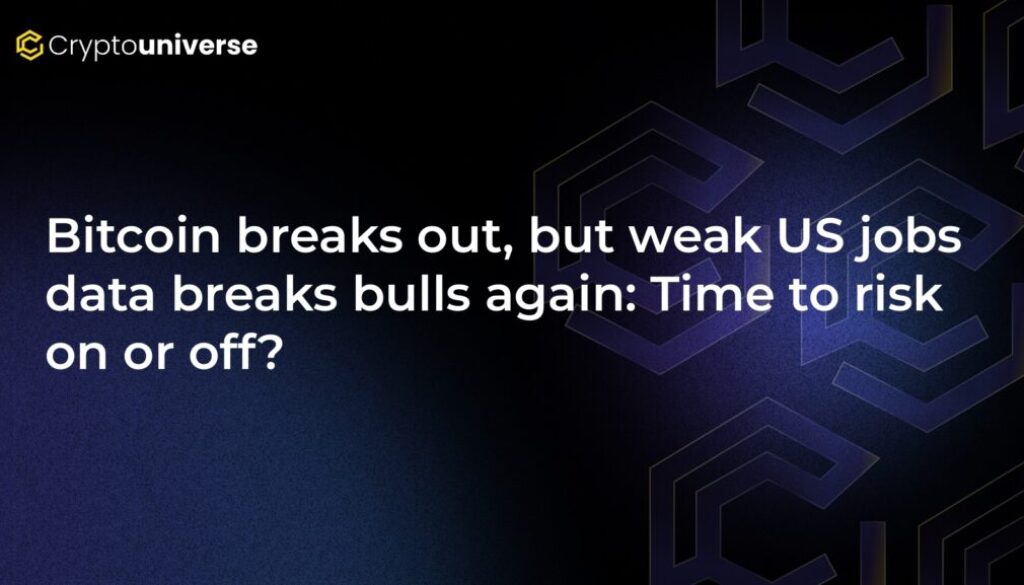Bitcoin breaks out, but weak US jobs data breaks bulls again: Time to risk on or off?

Bitcoin’s Rally Hits a Macroeconomic Wall
Bitcoin (BTC) traders were on the edge of their seats this week as the digital asset showed strong signs of life, surging nearly 5% to a peak of $113,384. The bullish momentum seemed perfectly timed, leading into a pivotal U.S. Nonfarm Payrolls (NFP) report on Friday. However, what followed was a classic case of market whiplash, leaving investors to ponder the crucial question: is it time to embrace risk or run for cover?
The market’s volatile reaction underscores a complex tug-of-war between bullish on-chain signals and confusing macroeconomic data. While Bitcoin breaks out, the reality is that
The Jobs Report Shockwave: Why Bad News Should Be Good News
The U.S. labor market data released on Friday was shockingly weak. The economy added a mere 22,000 jobs in August, a significant miss from the forecasted 75,000 and a steep drop from July’s 73,000. To add to the concern, the unemployment rate climbed to 4.3%, while wage growth slowed.
In the world of risk assets like Bitcoin, this kind of bad news is often interpreted as good news. Here’s why:
- Federal Reserve Rate Cuts: A weak labor market signals a cooling economy and easing inflation. This strengthens the case for the Federal Reserve to cut interest rates to stimulate growth.
- Increased Liquidity: Lower interest rates and potential quantitative easing (liquidity injections) tend to devalue the U.S. dollar, making alternative assets like Bitcoin more attractive.
With the probability of a Fed rate cut now soaring to over 88%, the macroeconomic stage seemed set for a sustained Bitcoin rally. But the market had other plans.
A Vicious Whipsaw: The Market’s Conflicted Reaction
Immediately following the NFP release, Bitcoin did exactly what was expected—it pumped. The price shot up, retesting the critical supply zone between $112,500 and $113,650. But the celebration was short-lived. The rally quickly disintegrated, and BTC tumbled 1.5%, sliding back below $111,000.
This violent price swing, often called a “whipsaw,” triggered a cascade of liquidations, wiping out over $63 million in leveraged long positions in just four hours. Such moves are frequently attributed to market makers hunting for stop-losses and capitalizing on crowded trades before a real trend is established.
On-Chain Data Reveals a Bullish Undercurrent
While the price charts paint a picture of chaos, the on-chain data tells a more optimistic story. A closer look at blockchain activity suggests that smart money was preparing for a move long before the jobs report.
Key on-chain signals include:
- Massive Stablecoin Inflows: In the days leading up to the report, over $2 billion in stablecoins flowed onto exchanges. This is widely seen as “dry powder”—capital parked on the sidelines, ready to be deployed into assets like Bitcoin and Ethereum when a catalyst appears.
- Record-High Open Interest: Despite recent price consolidation around the $110,000 mark, Bitcoin’s open interest has climbed above $80 billion, nearing its all-time high. This indicates that traders are building new leveraged positions and betting on future volatility, rather than closing out their bets.
This combination of available liquidity and high conviction from derivatives traders suggests a strong underlying belief in an upcoming upward move.
Technical Levels to Watch: The Deciding Factor
With conflicting signals from price action and on-chain data, the technical chart becomes the ultimate arbiter. The market structure can be viewed from two perspectives:
The Short-Term View: On the one-hour chart, the bullish structure remains intact for now. Bitcoin continues to print a series of higher highs and higher lows. This pattern is only invalidated if the price decisively breaks and closes below the key support level of $109,500. For now, the recent dip looks more like a liquidity grab than a full-blown trend reversal.
The Long-Term View: Zooming out to the weekly chart, caution is warranted. A single day’s price action is not enough to confirm a market bottom. The most critical signal for bulls will be the weekly candle close. A decisive close above $112,500 would provide strong confirmation that a durable bottom has been established around $107,500 and could ignite the next major leg up.
Conclusion: A Market at a Crossroads
Bitcoin is currently caught in a tense standoff. The macroeconomic environment is increasingly favorable for a rally, driven by the prospect of Fed rate cuts. On-chain metrics show that significant capital is ready to fuel the next move. However, the immediate price action reveals indecision and vulnerability to sharp, liquidation-driven pullbacks.
The question of whether it’s time to be “risk on” or “risk off” remains unanswered. While the underlying bias appears to be shifting upward, confirmation is key. All eyes are now on the weekly close. If bulls can reclaim and hold the $112,500 level, it could signal the start of a sustained uptrend. Until then, traders should prepare for continued volatility.


